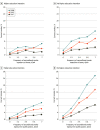Secondhand Smoke Exposure and Smoking Prevalence Among Adolescents
- PMID: 37862017
- PMCID: PMC10589809
- DOI: 10.1001/jamanetworkopen.2023.38166
Secondhand Smoke Exposure and Smoking Prevalence Among Adolescents
Abstract
Importance: Secondhand smoke is a substantial risk factor for youth health globally, including in Japan, where tobacco control policies should be reassessed.
Objective: To assess trends in the prevalence of secondhand smoke exposure among Japanese adolescents from 2008 to 2017 and to examine the association between its frequency and smoking during the study period.
Design, setting, and participants: This study comprised a nationally representative, self-administered, school-based, cross-sectional survey focusing on tobacco and alcohol use and related factors among students in grades 7 to 12 (ages 12-18 years) in Japan. This random sampling survey used single-stage cluster sampling. Using the national school directory, junior and senior high schools throughout Japan were randomly extracted from each regional block. All students enrolled in the sampled schools were included as participants, and school-based surveys were completed in 2008, 2012, and 2017. Data analysis was performed from January 1 to March 15, 2023.
Main outcomes and measures: Prevalence of secondhand smoke exposure among adolescents in Japan from 2008 to 2017 and changes in the association between secondhand smoke exposure frequency and prevalence of smoking were examined using multiple logistic regression analysis.
Results: Data were analyzed for 95 680 adolescents in 2008 (50.7% boys), 100 050 in 2012 (51.6% boys), and 64 152 in 2017 (53.9% boys). At baseline, 42.0%, 38.5%, and 34.6% of the participants were junior high school students in 2008, 2012, and 2017, respectively. Based on the 2008 surveys, 51.0% of adolescents in grades 7 to 12 were exposed to secondhand smoke in any place (≥1 day during the past 7 days), 37.2% were exposed at home, and 36.5% were exposed in public places. In 2017, 36.3% of participants were exposed to secondhand smoke in any place, 23.8% were exposed at home, and 27.0% were exposed in public places. An association between secondhand smoke exposure frequency and prevalence of smoking was observed consistently regardless of survey year, location, or pattern of exposure (adjusted odds ratios ranged from 2.29 [95% CI, 1.81-2.91] for 1-2 days at home to 11.15 [95% CI, 8.50-14.62] for 7 days in public places). Stratified analysis by higher education intention indicated that the prevalence of smoking and secondhand smoke exposure decreased but remained higher among adolescents who did not intend to pursue higher education. The association between secondhand smoke and smoking did not differ substantially between groups.
Conclusions and relevance: In this cross-sectional study, the prevalence of secondhand smoke exposure among adolescents in Japan decreased but remained at high levels overall. There may not be a hazard-free threshold for smoking. Enhancing comprehensive tobacco control strategies is Japan's first step toward achieving smoke-free environments to protect youths. Implementation and verification of the effectiveness of smoke-free legislation should be considered.
Conflict of interest statement
Figures
References
-
- International Agency for Research on Cancer . Tobacco smoke and involuntary smoking. World Health Organization. 2004. Accessed March 1, 2023. https://monographs.iarc.fr/ENG/Monographs/vol83/index.php
-
- World Health Organization . International consultation on environmental tobacco smoke (ETS) and child health, 11-14 January 1999, Geneva, Switzerland. 1999. Accessed March 1, 2023. https://iris.who.int/handle/10665/65930
-
- California Environmental Protection Agency Air Resources Board . Proposed identification of environmental tobacco smoke as a toxic air contaminant. California Environmental Protection Agency. 2005. Accessed March 1, 2023. https://ww2.arb.ca.gov/sites/default/files/classic/toxics/id/summary/ets...
-
- US Surgeon General . The health consequences of involuntary exposure to tobacco smoke. Report of the Surgeon General. 2006. Accessed March 1, 2023. https://stacks.cdc.gov/view/cdc/13252/ - PubMed
MeSH terms
Substances
LinkOut - more resources
Full Text Sources
Medical
Miscellaneous


